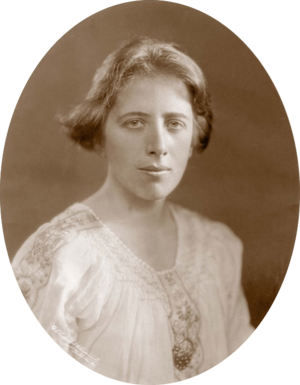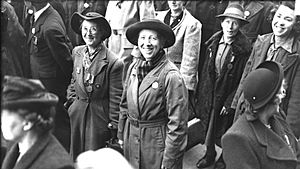Maire Comerford facts for kids
Quick facts for kids
Maire Comerford
|
|
|---|---|

Comerford, c. 1923
|
|
| Born |
Mary Eva Comerford
2 June 1893 Rathdrum, County Wicklow, Ireland
|
| Died | 15 December 1982 |
| Resting place | Mount Saint Benedict Cemetery in Gorey, County Wexford. |
Máire Aoife Comerford (June 2, 1893 – December 15, 1982) was an important Irish woman who believed strongly in an independent Ireland. She saw many key events during Ireland's fight for freedom between 1916 and 1923. She was a dedicated member of Cumann na mBan, a women's organization, throughout her life. Her book, On Dangerous Ground, which tells her story of the Irish Revolution, was published after she passed away.
Contents
Early Life and Beginnings
Máire Comerford was born Mary Eva Comerford on June 2, 1893, in Rathdrum, County Wicklow. Her father, James Comerford, owned a mill. Her mother was Eva Mary Esmonde. Máire had two brothers and one sister.
Her grandfather, Thomas Esmonde, was a brave soldier. He received the Victoria Cross, a very special award, for his courage in a war in 1854.
When Máire was 16, her father died. In 1911, she went to London to study at a secretarial school. Later, she returned to Ireland to live with her mother in Wexford. Around 1915, her mother opened a school in Courtown, Co Wexford.
Witnessing Big Changes (1916-1922)
Máire Comerford was in Dublin when the Easter Rising began in 1916. This was a rebellion against British rule in Ireland. She tried to help Countess Markievicz in St Stephen's Green, but was turned away. Máire then carried important messages for the rebels at the GPO.
After the Rising, she went back to Gorey. There, she joined the local Sinn Féin group. Sinn Féin was a political party that wanted Ireland to be independent.
Máire supported the Irish prisoners taken in 1916. She also helped to reorganize the Sinn Féin party from 1917. She returned to Dublin before the 1918 Irish general election. She worked on an election campaign there. Sinn Féin won many seats in this election.
On January 21, 1919, Máire saw history being made. She was present when the First Dáil was created. This was Ireland's first independent parliament.
During the Anglo-Irish War (also known as the Irish War of Independence), Máire helped the IRA in Dublin. The IRA was fighting for Irish independence. She also helped the Irish White Cross. This group raised money in the United States to help Irish people affected by the war.
The Irish Civil War
Before the Irish Civil War (1922-1923), Cumann na mBan, the women's group Máire belonged to, voted against the Anglo-Irish Treaty. This treaty created the Irish Free State but kept a link to Britain. Cumann na mBan wanted Ireland to be a fully independent republic.
In June 1922, Máire managed to escape from the Four Courts during the Battle of Dublin. This battle marked the start of the Civil War. The war caused a big split within the Sinn Féin movement.
In 1923, Máire was arrested. She was held in the women's section of Mountjoy Prison because she had a revolver. She was kept alone for three months.
Later Political Life
After the Civil War, Máire Comerford supported Éamon de Valera. He was a leader who wanted a fully independent Irish Republic. However, she disagreed with him when he decided to enter the Dáil (Irish parliament) in 1927. She believed in not compromising on Ireland's full independence.
In 1926, de Valera started a new party called Fianna Fáil. Many Cumann na mBan members joined this new party. But Máire stayed with the original Cumann na mBan. This group remained committed to a fully independent Ireland.
From 1935 to 1965, Máire worked as a journalist. She wrote for The Irish Press, which was Éamon de Valera's newspaper.
Later Years and Legacy
In 1967, Máire Comerford helped restore the Tailors' Hall in Dublin. This historic building was important in Irish republican history. In 1969, her book, The First Dáil, was published.
In the 1970s, Máire supported the Provisional Irish Republican Army during The Troubles in Northern Ireland. She especially supported the 1981 Irish Hunger Strike. In 1976, she was interviewed for a TV show called 'Curious Journey'. This show featured people who lived through the 1914-1923 period. These interviews later became a book.
Máire Comerford worked as a journalist until she retired in the 1960s. She never married.
Death and Remembering Her
Máire Comerford passed away on December 15, 1982, at 89 years old. She was buried in Mount Saint Benedict Cemetery in Gorey, Co Wexford.
In 2021, her personal story, On Dangerous Ground, a Memoir of the Irish Revolution, was published. It was edited by Hilary Dully.


